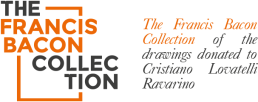Between 1977 and 1992 Francis Bacon donated to an intimate Italian friend a considerable number of drawings, pastels and collages.
Today those drawings are part of a collection which includes a few hundreds under a whole corpus: “The Francis Bacon Collection of the drawings Donated to Cristiano Lovatelli Ravarino”.
As Edward Lucie Smith – one of the most known and appreciated art historians in the world – wrote, the drawings and the pastels which are part of the collection are “complete works of art” and they are fully included in the iconography of the English-Irish artist who, towards the end of his life, revisited the themes he had previously experimented on, trying new formal ways.
In the “works on paper” – concealed to his vendors but donated to his friends: Paul Danquha, Stephen Spender, Brian Hayhow, Cristiano Lovatelli Ravarino and others- we can find crucifixions, popes, portraits and self-portraits: these are the subjects he painted during his long artistic life.
They show that when Francis Bacon, interviewed by David Sylvester, his official biographer, stated that he had never drawn preparatory works, he was wisely and consciously using words, and he was in fact telling the truth twice: it was true indeed that he used to sketch straight on canvas the lines of the work he had in mind without making any preparatory drawings (except for using other “ways”, as Barbara Steffen very clearly highlights in her studies); and it was also true that from the beginning of his “artist career” he was used to drawing and he had kept on doing this, discreetly but methodically, for all his life (see Mollie Craven’s testimony, reported in the book by Daniel Farson, “The Gilded Gutter Life of Francis Bacon”, 1993).
The works on paper show that one of the greatest painters of the 20th century was also a great draftsman.
It could not have been any different for someone who, like him, had decided to “become a painter” after having seen an exhibit of 101 drawings by Picasso in Paris at the Paul Rosenberg Gallery in 1927.
Francis Bacon was 18 then.
And “it is significant that it was a drawings’ exhibition to drive such a creative and explosive activity, but it is also meaningful that he started his career with Picasso’s drawings…which forewarned about formal inventions and techniques introducing “metamorphoses” of the plastic and pictorial language that will span his entire artistic production… Bacon is a plastic painter who through paper manages to cross over into sculpture by cutting and pasting, even composing the figure, as Picasso used to do with his “dessin decoupé”, a genre that the Spanish master had picked back up in his late career (history repeats itself) in order to set movie scenes or models for the creation of big sculptures.
From the plasticity of sketched papers to the cutting of drawn figures and their pasting onto paper and cardboard, that is a short step.
The preference given to curved lines which define the human figure is evident, in contrast with the background generally characterized by straight lines and angles; graphic marks common to the paintings where shapes are defined with a similar mark: it is impossible for someone who learns to recognize the “hand” not to capture in these drawings Francis Bacon’s personality” ( M. Letizia Paoletti: Francis Bacon and “dessins decoupé”, 2015).
